The Lord of the Rings TCG
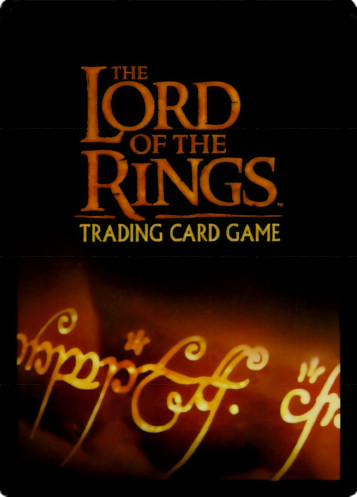
The Lord of the Rings Trading Card Game (or LOTR-TCG) is an out-of-print collectible card game produced by Decipher, Inc. It was a licensed product utilizing the imagery of the New Line Cinema films directed by Peter Jackson, and was first published one month before the films themselves in November 2001. Cards were printed across 19 sets right up until Decipher's license expired in 2007.
The game has both players mixing evil Shadow cards (Orcs, Trolls, Nazgul, and so on) with good Free Peoples cards (Elves, Dwarves, Hobbits, Wizards, etc) into the same deck. Players then play both roles, alternating between guiding Frodo to safety and attempting to kill him. This inherent struggle is portrayed using the innovative Twilight Pool mechanic, a cost system where Free Peoples cards increase the amount of Twilight, which Shadow cards then use as a resource.
The game was highly praised upon its release, winning industry awards[1] and even (according to Decipher's own suspect numbers) outselling Magic: The Gathering for a brief period shortly after its release.
The community surrounding the game has managed to stay active since the game's ending (and Decipher's subsequent dissolution), largely due to the presence of the digital platform GEMP where the game can be played online for free. GEMP, this wiki, and the game itself are all today managed by the fan-ran Player's Council, which issues errata and virtual sets.
Overview[edit]
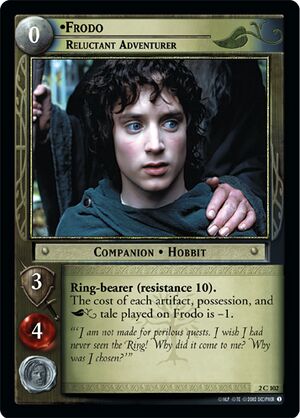
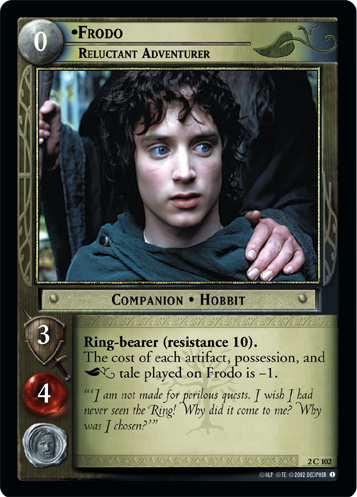 , one commonly-used Ring-bearer, who you must keep alive until the end of the game.
, one commonly-used Ring-bearer, who you must keep alive until the end of the game.The object of the game is for players to guide Frodo (or an Alternate Ring-bearer) along their journey to destroy The One Ring. If a player can guide their Ring-bearer safely to the end of a path of nine Sites, then that player wins the game. Free Peoples players can improve their chances by playing Companions such as Gandalf or Aragorn to protect their Ring-bearer, or equipping their Fellowship with Possessions or Artifacts, such as Sting (1R313)
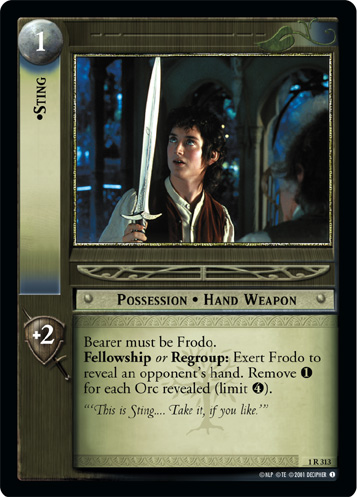 or Andúril, Flame of the West (7R79)
or Andúril, Flame of the West (7R79)
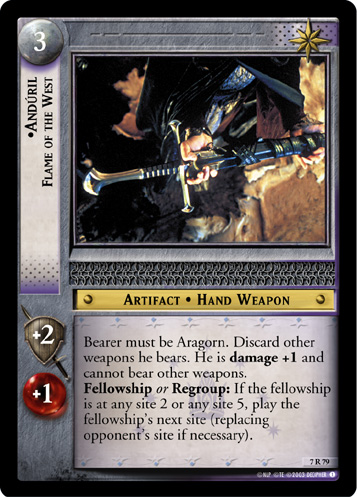 .
.
However, your Shadow opponents will be seeking to play powerful Minions such as Nazgul or The Balrog to corrupt or kill the Ring-bearer, and they can be equipped with their own fearsome weapons. Both sides can invoke lasting Conditions to affect the battlefield, or benefit from fleeting Events that can quickly turn the tide of fate.
Each player controls their own version of the Ring-bearer, and players alternate between guiding their own Frodo and trying to attack their opponent's. The game is essentially a race, with more effective Free Peoples sides managing to kill minions to pull ahead, and more effective Shadow sides producing enough obstacles to force the opposing Fellowship to halt and hide.
When Free Peoples cards are played, their Twilight Cost adds a given number of tokens into the Twilight Pool. Twilight represents the attention and awareness of the forces of evil, and as the size of the Twilight Pool grows, so too does the danger to the Fellowship. Shadow cards pay their Twilight Cost by removing tokens from the Twilight Pool, so every card played presents an inherent risk-reward dilemma. The game thus does not follow a linear mana growth, as any player might choose to risk Flooding the pool at any time. Alternatively, some Fellowships sneak quietly and instead Choke the pool, leaving as little trace for the Enemy to follow as possible.
Since players are alternating between both roles, two equally-sized decks (one Free Peoples, one Shadow) are shuffled together to create a unified Draw Deck. Properly managing both sides of this deck is an important skill, lest the player be left with too many cards of one side or the other in their hand at the wrong time. Care must also be taken to choose compatible strategies with both sides--if both sides are fighting for hand space, it can all fall apart in a hurry.
Development History[edit]
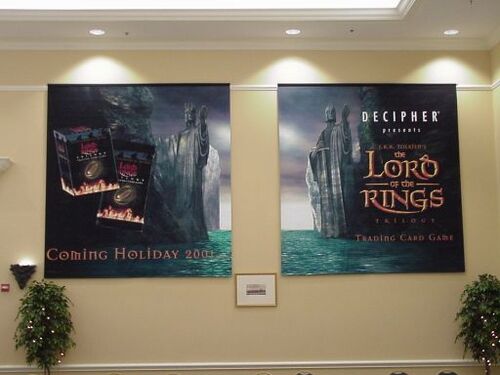
In August 2000, Warren Holland (Owner and CEO of Decipher) announced at GenCon that Decipher had obtained the rights to create a CCG based on the then-upcoming New Line Lord of the Rings films[2]. Details were initially scant as the ink had only just dried on the contracts, but development on the premiere set, The Fellowship of the Ring, continued quietly for a little more than a year.
Decipher veterans Chuck Kallenbach, Tom Lischke, Justin Pakes, and Joe Alread formed the initial design team, with Mike Reynolds re-joining Decipher[3] and adding his prior experience from Iron Crown Enterprises (ICE) where he worked on the Middle-earth CCG. Although the LOTR-TCG does not appear to have started with MECCG's design in mind, several concepts appear to have independently converged, including the mixed Shadow/Free Peoples draw deck and the central conceit of traveling between sites. Likely due to Reynold's influence (and the shared source), many of the specific wording and naming details line up between the two games, but aside from that the games are largely dissimilar.
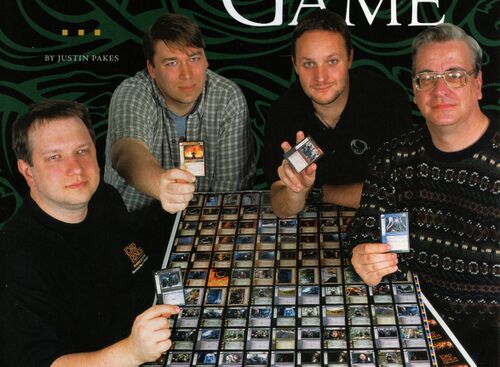
Decipher executives worked closely with Weta Workshop (the visual effects team) and New Line Cinema to obtain as many film images as possible, which in some cases resulted in early or alternate shots that didn't end up making their way into the film itself. Peter Jackson and Weta Digital were still working on the film during Decipher's own production, so many details (especially special effects shots) ended up tweaked or replaced in the run-up to the release of the film. As a result, some portraits that were printed on cards are the only publicly released versions of certain images.
Due to this early access, certain story elements were not permitted to be portrayed by Decipher, both for practical reasons and for spoiler containment. The Balrog, for instance, was not included in the premiere set and had to be saved for Mines of Moria four months later.
The talent involved had years of experience developing prior Decipher properties, most notably the Star Wars CCG. Many of the hard lessons learned from that game had their solutions baked into the DNA of the LOTR-TCG, and its fingerprints can be felt all over, often notably in what the game does not do. For instance, the SWCCG tended to make main characters very rare, which could lead to the unfortunate result of a player ripping open pack after pack of Star Wars product and having essentially no chance to play the high-profile characters of the series--Luke Skywalker, Darth Vader, and so on. From the beginning, all Lord of the Rings sets ensured that main characters came in both common and rare varieties, so even the most unlucky pack opener would have a small pile of easily-obtained Legolas, Prince of Mirkwood (1U51)
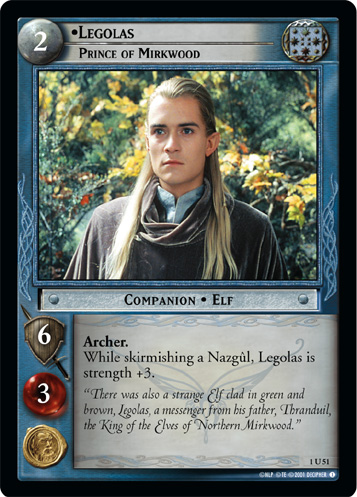 , even if the rare Legolas, Greenleaf (1R50)
, even if the rare Legolas, Greenleaf (1R50)
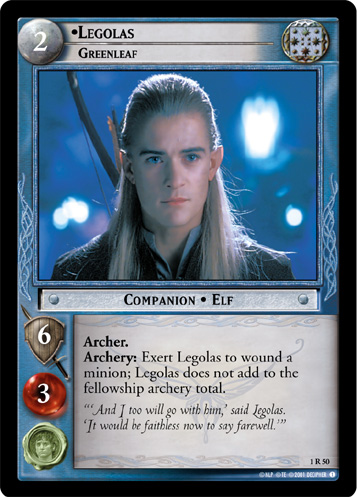 eluded them.
eluded them.
The organization of each set also owed itself to prior Decipher games. Each card was given a clearly-identifiable numeric ID in the form of Collector's Info in the bottom-right of each card, as imported from later Star Trek CCG editions. The strict Title/Subtitle system was also imported from later Trek, in lieu of the somewhat more ad-hoc naming system utilized by Star Wars.
The skill and experience of the design, development, and art teams eventually culminated in a massively popular release. In 2002, the LOTR-TCG won the Origins Awards for "Best Trading Card Game of 2001" and "Best Graphic Presentation of a Card Game 2001". Comics and Games Retailer magazine even reported sales overtaking Magic: the Gathering for a few months[4].
In December 2001, Warren Holland revealed that Decipher had lost the license to Star Wars. With Star Trek currently in the middle of a shift between editions, this made the freshly-minted (and fortunately popular) Lord of the Rings suddenly need to take the role of the most profitable property Decipher had active. For a time it was up to the task, but before long tremors would begin to accumulate under the strain.
Movie Era[edit]
Following the release of The Fellowship of the Ring film, the game entered into a steady cadence of 1 base set release per film, with 2 expansion sets spaced evenly through the intervening year. This era is appropriately called the Movie years, as the focus of each set was closely tied to the specific plot of its associated film.
Each "block" of sets introduced its own unique site path, as well as adding new mechanics, Keywords, and Cultures as appropriate. As with FOTR, "spoiler" elements (and late visual effects shots) would be relegated to the expansion sets, meaning that Gollum was not revealed in the base The Two Towers set, nor were Shelob or the Army of the Dead in The Return of the King.
In 2003, Decipher partnered with World's Apart to produce a digital version of the game, which enforced the rules and offered online-only cards and mechanics. See Lord of the Rings Online TCG for more details.
The Reflections set was inserted into the release schedule during King block, taking the set 9 position and pushing Mount Doom to set 10. Reflections introduced some significant changes to the core design of the game in the form of Alternate Ring-bearers. This change was overseen by the original design team, but around this time they began to be pulled away to work on other properties, most notably the WARS TCG. It marked a sea change in the direction of the game, and set 10 was the last Movie block set.
Movie Era Sets[edit]
- The Fellowship of the Ring (November 6, 2001) - The first base set that introduced the core mechanics of the game. The cards were divided between
Dwarven,
Elven,
Gandalf,
Gondor and
Shire cultures on the Free People sides and
Isengard,
Moria,
Ringwraith and
Sauron cultures on the Shadow side. Certain cards foreshadowed the release of future cards, such as The Balrog and the Artifact card type.
- Mines of Moria (March 6 & 13, 2002) - The first game expansion introduced the Artifact type of cards, which function identically to Possessions but tend to be harder to discard. This expansion highlighted the
Dwarven and
Moria cultures, and of course finally released The Balrog, who would go on to become a staple in Fellowship Block due to the mandatory The Bridge of Khazad-dûm (1C349)
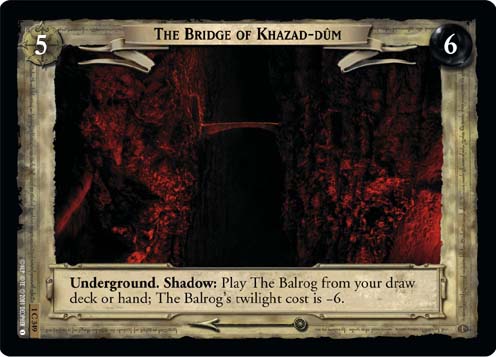 site.
site. - Realms of the Elf-lords (June 19 & July 3, 2002) - This set focused on the
Elven and
Isengard cultures, and featured the first playable versions of Saruman.
- The Two Towers (November 6, 2002) - The second base set brought the first significant overhaul to the game. The site path from The Fellowship of the Ring was completely replaced with new sites from The Two Towers, and sites could now be controlled by Shadow players and liberated by the Free Peoples. The set contained no cards for
Moria,
Ringwraith or
Sauron cultures, but new Shadow cultures of
Dunland and
Raider (which combined the Southrons and Easterlings) were added along with the
Rohan Free People culture.
- Battle of Helm's Deep (March 12, 2003) - This set brought back the
Sauron culture and also introduced the new
Gollum culture, unique in the game in that it contains both Free People and Shadow cards (reflecting Smeagol/Gollum's dual personality).
- Ents of Fangorn (July 2, 2003) - This set brought back the
Ringwraith culture and introduced new versions of the Ents which were more pro-active in combat than the previous versions, which had specific requirements to be allowed to skirmish. It also contained new cards of the
Moria culture, including a version of the Balrog who could be played on sites other than Underground.
- The Return of the King (November 5, 2003) - In addition to completely replacing the site path once again, the third base set added the new mechanics of threats (tokens that had to be assigned as wounds when a companion or ally was killed) and initiative, which either Free Peoples or Shadow player had based on the number of cards in their hands. This set contained no cards of
Dunland,
Isengard and
Moria cultures, but added Minas Morgul orcs to the previously Nazgûl-only
Ringwraith culture.
- Siege of Gondor (March 10, 2004) - This set significantly boosted the [Raiders] culture by enhancing it with the Corsairs of Umbar and added the Dead Men of Dunharrow to the [Gondor] culture. It also introduces Shelob as the only other minion for the [Gollum] culture and featured characters with the powerful keyword enduring, who increased in strength after gaining each subsequent wound.
- Reflections (May 12, 2004) - Released in between two expansions of The Return of the King block, this special set was the most innovative at the time. Characters from the Prologue of The Fellowship of the Ring such as Elendil and Gil-Galad were introduced for the first time and characters from the books that were abscent from the movies such as Glorfindel and Tom Bombadil were added through the designs created by Weta Workshop specifically for the game. Most importantly, characters other than Frodo were allowed to be the Ringbearer for the first time, featuring versions of Galadriel, Boromir, Smeagol and others who could bear the One Ring instead. More alternative Ringbearers would be added in later sets.
- Mount Doom (July 14, 2004) - The final set of the "movie" release era introduced new powerful versions of several characters such as Éowyn, Arwen and Sam that would remain the preferred choices for many of the deck strategies.
Shadows Era[edit]
With the release of Shadows, set 11, Decipher knew they needed to pivot their focus. With no further movies coming out, the game needed to be able to stand on its own release schedule, without tying too much of its identity to the plot of any individual film. Shadows thus introduced the largest changes yet to the core formula, a move that was ultimately very controversial among fans.
The site path was reconfigured for the final time to no longer rely on any one movie's site path. The Shadows-block site path instead removed the numbers from all sites, making them "wildcards" that could be placed in any position. The strategic and mechanical potential was great, but many players decried the loss of thematic movement, and called the new movement "teleporting" between sites. The site path would not be replaced with Hunters Block, but built upon.
All Shadow Cultures were also reworked. Rather than sticking to the faction-based divisions ( Isengard,
Moria,
Sauron), all Shadow cultures were rearranged into Race-based divisions instead, giving way to
Orc,
Men, and
Uruk-hai, as well as the rebranded
Wraith and mostly-unchanged
Gollum. Decipher said this would let them reuse movie footage for Shadow card art, a limited resource which made extending previous Shadow cultures difficult. Although it is possible to speculate on the exact reasons for this change, the mechanical benefits are somewhat less obvious, and many players viewed this as a forced obsolescence of already-owned card product.
New mechanics and Keywords continued to be added within new sets, and for a time the game struggled on. However, with the strategic failure of WARS in 2005 and the lack of any major successes among any of Decipher's other licensed properties, the LOTR-TCG buckled under the combined strain of unpopular changes to the game on one hand and the financial stress of the company on the other. In 2005 Decipher was forced to lay off much of its staff, which led to a long drawn out spiral as the remaining staff struggled to release product on schedule, which led to major delays and evaporation of retailer and player faith, which led to loss of revenue, which led to more layoffs, until nothing was left of Decipher.
Although Warren Holland managed to keep the company out of bankruptcy, for a time only a single employee was on staff doing the work of dozens to wrap up the final three sets. Each one released to smaller fanfare than the last, until finally the company's originally contracted license date expired in 2007. Decipher attempted one last gasp in the form of a new game, Fight Klub, and then the organization faded from existence, not truly dead, but not truly alive, either.
Shadows-era Sets[edit]
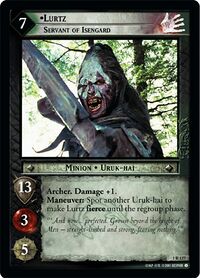
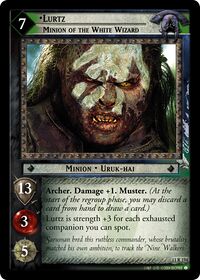
- Shadows (November 3, 2004) - The release of the new "base set" saw the most significant overhaul of the game, which would remain to be seen unfavorably by many players. Existing faction-based Shadow cultures of [Dunland], [Isengard], [Moria], [Raiders] and [Sauron] were replaced with more generic [Orcs], [Uruk-Hai] and [Evil Men], leaving only [Ringwraith] and [Gollum] unchanged and making the majority of the old cards incompatible with the new cultures. Companions other than the Ring-Bearer now also had Resistance, which was affected by both Free People and Shadow cards. Most importantly, instead of a numbered site path based on an individual movie, the nine sites from all three films could now be played in any order and replaced continuously by both Free People and Shadow cards. While this allowed for new gameplay strategies, many felt that the core aspect of the game no longer made sense story-wise.
- Black Rider (March 18, 2005) - The first post-"Shadows" expansion was notable for reprinting many prominent cards from The Fellowship of the Ring block, which because of the recently introduced block rotation were no longer legal in the Standard tournament format.
- Bloodlines (August 12, 2005) - This set introduced the new Follower card type - minor characters who could provide their Aid to the Fellowship for a cost that must be paid each turn. It also included the only cards that could change their card type in the form of conditions that could turn into minions and back.
- Expanded Middle-earth Deluxe Draft Box (February 17, 2006) - Similar to "Reflections", this 15-card set used artwork by Weta Workshop to represent characters from the books not included in the films, such as Halbarad, Grimbeorn and Dáin Ironfoot.
- The Hunters (June 9, 2006) - Released after a significant delay due to the financial problems experienced by Decipher, Inc., this new base set introduced a new powerful keyword Hunter and doubled the amount of available Followers.
- The Wraith Collection (August 26, 2006) - This Deluxe set had only six cards and consisted entirely of Minions of the [Ringwraith] culture, half of whom used artwork by Weta Workshop to represent the Barrow-wights.
- Rise of Saruman (March 1, 2007) - Released after another long delay, this set featured the only Free People character to be represented by more than one culture by introducing the [Rohan] version of Aragorn. It also contained no less than five different versions of Saruman, one for each culture, including the only Shadow follower in the game.
- Treachery and Deceit (May 2007) - Rushed to release before the impending expiration of the license, this set suffered from a lack of playtesting and contained the largest number of overpowered or "broken" cards, for which official errata had to be released almost immediately. This set also received the smallest printing of all and remains incredibly hard to find in circulation.
- Age's End (June 2007) - Released mere weeks before Decipher's license expired, this final "farewell" set consisted of 40 Promo-rarity cards available in a single Deluxe box. It featured the final versions of many prominent characters, some of which have been noted to be more powerful than any of those that came before.
Post-Decipher Era[edit]
Following the decline of Decipher, the community managed to huddle around The Last Homely House, an aptly-named forum ran by a fan named Kralik. The old Decipher website was scoured for card images, and an image DB (later a wiki) was propped up for people to reference. Trading was alive and well, and people organized local meetups and mused over how to address the rusted balance of the game. Following the example of the (official) Star Wars CCG Players Committee, and the later (unofficial) Star Trek CCG Continuing Committee, a few attempts were made to establish an equivalent organization for the LOTR-TCG, but each one petered out.
World's Apart, still under contract in spite of being acquired by Sony Online Entertainment, and in spite of Decipher ceasing to meaningfully exist, continued to leave the Lord of the Rings Online TCG running until being shut down in June of 2010 (although no cards could be purchased after May 2007).
Unofficial clients had always been used, but with Decipher no longer around to disincentivize their use, the community moved from one platform to another as better candidates were made or discovered. First sDA was used, and later gccg and LackeyCCG, but in 2012 MarcinS set up the GEMP platform as a fully rules-enforced website. The community switched to GEMP and never looked back.
For a decade, nothing changed. Games continued to be played on GEMP, trades continued to be had on TLHH, and the heart of the community slowly beat in obscurity.
Player's Council Era[edit]
In 2020, the world was thrown into disarray by the Covid-19 pandemic. As countries entered lockdown, people began to open up their closets in boredom, and an absolutely enormous number of people rediscovered their old game hobbies all at once. Practically every dead CCG went through an explosion of activity, and the Lord of the Rings TCG was no exception.
Riding the crest of that popularity, a small group of fans finally managed to organize a continuing committee with some staying power, and the Player's Council was born. They contacted Kralik and MarcinS, and took over management of TLHH and GEMP.
PC Sets[edit]
- V1 - Shadow of the Past (August 2022) - The inaugural virtual set issued by the Player's Council, V1 was intended to be a supplementary set to The Fellowship of the Ring, and used in any format where that set was legal. Specific FOTR-era strategies were bolstered, including Signets,
Moria Tentacles, Twilight Nazgul, and
Sauron Grind. Characters and concepts that Decipher never adapted were also included, such as
Isengard Crebain.
PC Errata[edit]
Full article: PC Errata
In addition to new sets, the Player's Council also took the first step to addressing existing overpowered cards through the use of errata. Traditionally, Decipher avoided altering card text except in the case of the latest set that had been released, but their hesitance to alter a physically purchased, printed card relied on pressures that did not apply to the PC. With most gameplay centralized on GEMP, there was a single source of truth that could be instantly deployed to all players.
Several rounds of errata have been issued to date by the PC, first addressing cards banned by Decipher, and later working their way down well-known OP cards and common Negative Play Experience (NPE) strategies such as deck discard. See PC Errata for the full list.
World Championship[edit]
Every year, Decipher ran sanctioned leagues and tournaments through the Decipher Game Management Authority (DGMA), which culminated in Worlds near DecipherCon in September. Decipher ran events in the Standard Format, which highlighted the latest sets released for that particular year.
Much of the specifics have been lost to time, especially from 2005 onward. All decks that are known are listed in this thread on TLHH.
| Year | Champion | Runner Up |
|---|---|---|
| 2002 | Mathieu Brochu | Alex Tennet |
| 2003 | Michael Dalton | Robert Schiermeyer |
| 2004 | Emir Delic | Josh Cornwell-Mott |
| 2005 | Kyle George | Lee Clarke |
| 2006 | Christian Kriesel | Seth Maser |
| 2007 | Vince Accetturo & Chris Thompson | |
| 2010 | Brian Fred | Casey Anis |
| 2023 | TBD | TBD |
2007 World Championship controversy[edit]
Since the rights to produce the Lord of the Rings TCG were lost earlier in the year, there was no legal way for Decipher to promote a World Championship, but they did still hold an unofficial event where the 2007 World Champions were crowned. The event was still held in Indianapolis, IN at GenCon on Friday, August 17, 2007 at 11:00 AM. The field was bested by Vince Accetturo and Chris Thompson, both members of the player group Team Bison Bucks. They decided to split the prize in the finals, declining a final match.
2010 World Championship[edit]
With no official governing body for the game existing after 2007, no official World Championships could be held. No group stepped up to attempt an unofficial World Championship event until 2010 when the Star Wars CCG Players Committee decided to run a de facto World Championship for Lord of the Rings at their annual Worlds Weekend event. Brian Fred was crowned champion as the only undefeated player at the event, in which close to 20 players participated.[5]
2023 World Championship[edit]
With the establishment of the Player's Council, a group finally existed to run such events again. The 2023 World Championship ran multiple smaller qualifying events throughout the year, culminating in a Group Stage ran on October 14th, 2023, and a Championship Tournament to be ran on October 21st, 2023. Full details on the event itself on the PC website here.
Unlike the Decipher events, a split-format approach was used to accommodate the popularity of multiple formats. The PC-Movie and PC-FOTR formats were both played during each crowning event, requiring players to provide 2 decks at minimum.
References[edit]
- ↑ Origins Award Winners(2001)
- ↑ Radio Free Decipher episode 46 (video reupload). Although most of the episode is lost to time, the portion involving the LOTR announcement thankfully remains intact.
- ↑ Radio Free Decipher episode 81 (video reupload).
- ↑ Scrye Collectible Card Game Checklist & Price Guide, Second Edition, page 295. It should be noted that such point-of-sale numbers were voluntarily reported by each individual store, and Decipher had a vested interest in drumming up motivation among local game retailers to make such reports. Wizards of the Coast had less reason to tout the Magic sales numbers: the unpopular Odyssey was released in September 2001, and Torment was not released until February 2002. The Fellowship of the Ring on the other hand was released right in between them, on the back of what would later be recognized as one of the biggest film trilogy releases ever. With all those caveats and asterisks--sure, LOTR may have beat MTG, briefly, in one metric. Only one of those games is still in print today.
- ↑ LOTR Worlds Event 2010